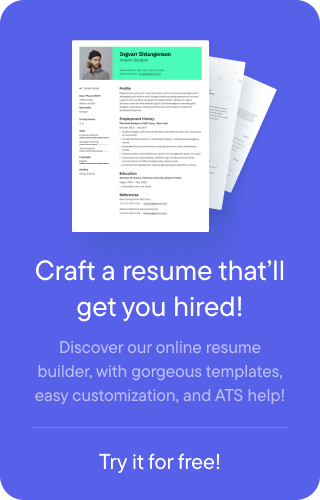- Career Advice
- Resume & CV's
- Let us help remind you: what are essential resume sections?

Let us help remind you: what are essential resume sections?
Artwork by: Sasha Serdyukova
- Resume sections: Why content matters so much
- Contact information: the first thing recruiters see
- The title section: your name and dominant career position
- Your summary section: describe your experience, strengths, and abilities
- Sections of a resume: Skills list - include SEO-friendly keywords
- Your accomplishment section: make yourself stand out
- The experience section: your professional work history from end to beginning
- The education section: focus on colleges and technical diplomas
- Resume categories: Your licenses and certificate section
- Only include professional references if they give you permission
- Key takeaways
Do you want to change careers or jobs and need to write a resume? Professional resumes take many forms but should alway contain certain universal features. We’ll examine the form and function of several popular resume sections, identifying parts that are essential to promoting your accomplishment and impressing recruiters.
There are many ways to format a professional resume and no shortage of formats you can use to describe your experiences. That said, there are several essential sections no resume should be without.
This article’s goal is to identify these essential resume sections, explain why they’re important, and share formatting tips that will make these sections stand out to recruiters and hiring managers. We’ll cover:
Why content matters
The contact section of a resume and where it should go
The title section of a resume and how it should describe you
The summary section of a resume and the qualities it should present
The skill section of a resume and the keywords it should use
The general accomplishments section of a resume and what it should highlight
The experience section of a resume and how it should be organized
The education section of the resume and what it should discuss
The license and credentials section of the resume and how detailed it should be
Professional reference sections and whether you should include them
Resume sections: Why content matters so much
The art of finding a job has changed recently thanks to the internet and the recent COVID-19 pandemic, and trends for professional resume design have changed with it.
In a world where job-seekers can use job board websites to apply to many jobs at once, the modern digital resume must be resilient and direct. When a staff member in a company’s HR department looks at your brand-new resume, they’ll probably toss it if they don’t see the information they need to know in the first page or two.
There’s a big difference between resumes for management positions and resumes for customer service roles – and both will be wildly different from resumes made for seekers of government or military positions.
Despite these differences, there are certain essential sections that should be found in nearly every modern resume or CV as determined by professionals, psychologists, and analysts who have discovered the most reliable ways to present career information.
Contact information: the first thing recruiters see
The content of a professional resume’s first page may vary, but your contact information should always be at the top of your resume’s first page, typed out in clear, legible, attention-grabbing text.
If the HR staff member reviewing your resume can’t find your contact info, they won’t be able to reach out and request an interview. If they can’t contact you with an interview request, it doesn’t matter how well-designed the rest of the resume is.
The bare essentials for resume contact info are your email address and preferred phone number. Besides these bits of information, you can also add an html link to your profile on LinkedIn or other job websites. Finally, you can include information about your current hometown and country of residence, though you’re not obligated to share your home address.
Statistical Insight According to Business Insider, 33% of hiring managers will reject resumes that don’t describe the applicant’s current vaccination status. As more and more people get COVID-19 vaccinations, this factor of resume evaluation might go away. Until then, it may be worth adding a brief section to the end of your resume that describes your current level of immunization – the date of your primary COVID-19 vaccination, plus the dates of any booster shots you received. |
The title section: your name and dominant career position
The title section of your resume is both essential and simple.
List your full name in large, bold font on the first page – either right on the top, in the top-left corner, or right below your contact info. Below the name, list your dominant career position(s) – the role(s) you excel at now or excelled at in the past as well as a short power statement if applicable.
With this information clearly laid out, HR personnel looking at your resume will know what your professional goals are and whether they match the opening they want to fill.
Your summary section: describe your experience, strengths, and abilities
While the skill section of your professional resume lists professional tasks you’ve mastered, and the experience section outlines the specific responsibilities of your past jobs, the summary should describe qualities that make you a great employee for any company that hires you. It shouldn’t just repeat the content of the skill and experiences sections, especially since they come after this section.
Start by describing your most universal work experiences, the tasks and duties you’ve performed repeatedly over the course of multiple careers. Talk about the methods and attitudes you employ to complete these tasks, describing them using keywords that appear in the job descriptions for the roles you’re pursuing.
If you want to describe specific skills in the resume summary, focus on describing impressive soft skills like interpersonal communication. Wrap up the summary by discussing your aspirations – the positions you want to attain and the challenges you want to overcome.
Example Resume Summary Section Template: A diligent, hard-working [position name here] with extensive experience in [skill/responsibility #1] and [skill/responsibility #2]. Employs [quality #1] and [quality #2] to complete [task #1] in a timely, professional fashion. Builds rapport with clients and colleagues using strong communication skills and [attitude #1]. Constantly strives to refine [skill name(s)] and seek out opportunities to [responsibility #3]. |
Sections of a resume: Skills list - include SEO-friendly keywords
If the summary section of a resume is formal and elaborate, the skill section of a resume should be a starkly simple bullet-point list of work skills that you’re good at. Describe each skill with a simple word or phrase that doesn’t take up much space in the lists.
Additionally, try to use skill terms that are popular and Search-Engine Optimized, making it easier for companies that use applicant-tracking software to spot your application by scanning the keywords in your resume.
Your accomplishment section: make yourself stand out
Accomplishment sections usually go right before a resume’s experience section, which may also list special accomplishments from your time working at each past position. The difference between your work experience section and your accomplishment section is a matter of scale.
Every accomplishment in this section, whether a deal you closed or a project you completed, should be a remarkable achievement in your career history. By putting these endeavors – sterling examples of your work ethic, creativity, problem-solving skills, and/or leadership abilities – on the front page of your resume, recruiters and HR staff are less likely to miss it.
The experience section: your professional work history from end to beginning
If a recruiter is impressed by the summary, skills, and accomplishments listed on your resume’s first page, they’ll likely read it all the way to the end to glean all the information they can about your career history. For this reason, the experience section of your resume must be detailed AND digestible, describing the most important events of your past careers while not overwhelming HR staff with trivialities.
Most resume experience sections start by describing a job-seeker’s most recent position then go on to summarize the applicant’s previous careers in reverse chronology. In most experience section templates, the job title and company name go first, followed by a paragraph describing the position’s responsibilities, and ending with a bullet-point list of unique accomplishments such as promotions or commendations.
Newer positions, since they better represent your current level of proficiency, should be described in detail, while older positions can be described more sparsely.
Expert Tip Should you include the start and end dates of previous positions in your resume? If so, how specific should you be with your dates? Most of the time, it’s prudent and helpful to include the duration of your past careers in your resume. To the right of each job title, list the month and year you started working, type out a dash mark, then list the month/year you left the position (or the word “present” if you’re still working there). There are two reasons to not include dates in your job descriptions. If your career history spans ten years or longer, recruiters looking for eager, energetic employees might reject your application out of hand, unfairly assuming that you’re “too old” for the position. If the start and end time of your past careers is less than a year, recruiters might also think you’re a fickle employee who hops from job to job. To avoid either of these harmful assumptions, you can add an “Additional Experience” section to your resume, describing very old or briefly held jobs in basic terms and omitting data about their start and end. |
The education section: focus on colleges and technical diplomas
In curriculum vitae resumes or CVs, a person’s educational credentials are placed at the start of a resume before their skills or work experience; these CV formats work best for job seekers who’ve just graduated or are searching for an academic or scientific position.
Most other modern resume templates prefer to place the education section after the work experience, a capstone to the job applicant’s accomplishments in the workforce.
Education sections should mostly focus on the colleges, universities, or vocational/technical schools you’ve attended. If you studied at an institution that granted you an official diploma, it’s worth describing in this section.
Do | Don't |
Cite the following in your resume’s education section: | Cite the following in your resume’s education section: |
Institution Names | High school diplomas (unless you haven’t graduated from college yet). |
Degrees such as Bachelor of Arts (BA), Master of Arts (MA), or Master of Business Administration (MBA) | An average GPA |
Doctorates and PhDs | Falsehoods or exaggerations |
Fields of Study | Club or sport team affiliations |
Your GPA if it’s well above the average | |
Graduation dates* | |
Honors or Dean’s Lists |
*If you graduated more than ten years ago, it’s best to leave out graduation dates as they can trigger age discrimination in some situations.
Resume categories: Your licenses and certificate section
If you’ve passed a certification course or earned a professional license of some kind, add a license/certificate header on your resume and list the following: the name of the certificate/license, the institution that issued it, and the date issued. Doesn’t have to get more complex than that.
Ideally, the licenses or certificates you mention should be relevant to the career you’re pursuing: an advanced driver’s or pilot’s license for transportation, a software operation license for a data processing job, etc.
Irrelevant licenses are still worth including in your resume if they show you’re an expert in a challenging technical field. Even if your expertise is in a niche area, you may stumble across an employer who needs it one day.
Only include professional references if they give you permission
Professional references were once a mandatory part of resumes back in the 20th century. With the advent of the internet, though, the contents of a professional resume – and any contact information on it – can theoretically fall into the grasp of a thousand different people and organizations. This state of affairs has made people understandably leery about letting job-seekers spread their contact information around willy-nilly.
Because of this, you should always follow these two rules of etiquette when pondering whether to list professional references on your resume. First, only share the contact information of former managers/colleagues/mentors if they give you explicit permission. Second, only add a reference section to your resume if the recruiters or the job description specifically requests it.
Key takeaways
HR staff members looking at your resume should see your name, contact info, and current or desired job title before anything else.
Your summary gives employers an overview of your personal strengths, your long-term goals, and what motivates you.
The skill section doesn’t just list the tasks you mastered but acts as a hotbed of keywords that resume-scanning software can spot so you move forward in the hiring process.
Accomplishment sections should be on the first page of your resume and list your finest, most career-defining achievements.
Recruiters looking at your resume’s experience section will closely analyze your most recent job descriptions; these entries should contain more details than older positions..
Education sections should focus on the college-type institutions you attended and the degrees or certificates you received.
Only add professional references if the business you apply to request it and the references in question give their consent.


